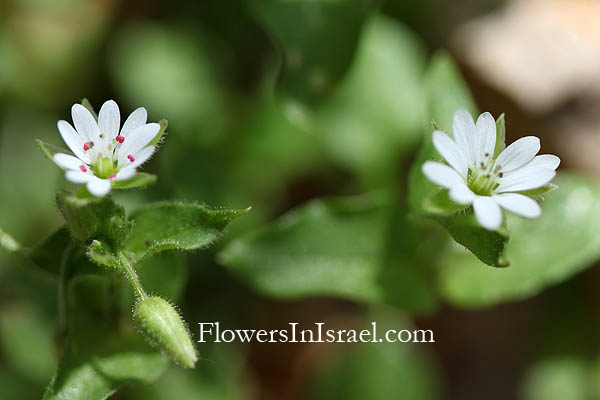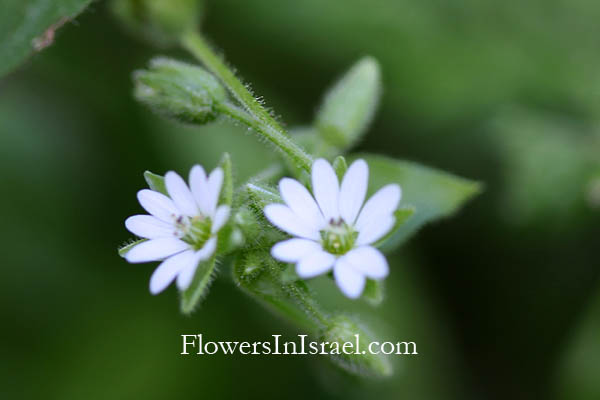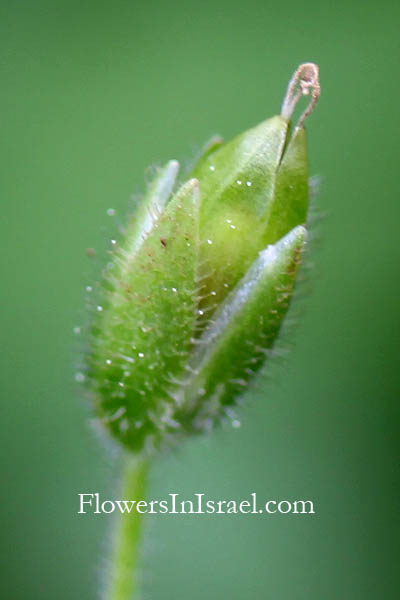Hebrew: כוכבית גדולה
| Scientific name: | Stellaria cupaniana (Jord. & Fourr.) Beguinot | |
| Synonym name: | Stellaria media var. postii Holmboe | |
| Common name: | Chickweed | |
| Hebrew name: | כוכבית גדולה | |
| Plant Family: | Caryophyllaceae, ציפורניים |

Location: Carmel, Hurshat Ha'arbaim |
| Life form: | Therophyte, annual | |
| Stems: | To 50cm long, 20-30cm tall, decumbent; fine hairs on only one side of the stem in a single band | |
| Leaves: | Opposite, entire, smooth | |
| Flowers: | 5 white petals, shorter than the sepals and deeply incised nearly to their base, giving the appearance of flowers with 10 narrow petals; 5 sepals about 5 mm long, oblong-lanceolate in shape with obtuse to acute tips; rounder petals than Stellaria media | |
| Fruits / pods: | Capsule, glabrous, with about 15 seeds; seeds 1mm in diameter, tuberculate, rotund | |
| Flowering Period: | January, February, March, April | |
| Habitat: | Batha, Phrygana | |
| Distribution: | Mediterranean Woodlands and Shrublands | |
| Chorotype: | Pluriregional; boreal-tropical | |
| Summer shedding: | Ephemeral |

Location: Carmel, Hurshat Ha'arbaim Derivation of the botanical name: Stellaria, Latin stella, "star,", referring to the star-shaped flowers. cupaniana, after the Italian monk Francesco Cupani (1657 - 1710/1711), botanist and author of works on Sicilian plants. media, in the middle, between; intermediate. The Hebrew name: כוכבית, cochavit, translation of the scientific name, which derives from Latin stella (כוכב, cochav, =star).
Beside chickweed's medicinal uses for humans, John Gerard (1545 - 1611/12), English botanist, commented "Little birds in cages, especially Linnets, are refreshed with the lesser Chickweed, when the loath their meate." Gerard also said that you should boil the leaves of Chickweed in water until they are very soft, adding some lard, fenugreek powder and ground linseed and a few marshmallow roots, mixing together well to make a pultesse (poultice) to be used to remove swelling of the legs or any other swelling. He said also that "the leaves boiled in vinegar and salt are good against mangines of the hands and legs, if they be bathed therewith". Nicholas Culpeper (1616–1654), English botanist, herbalist, physician, and astrologer, in his Complete Herbal published in the 1600's, described chickweed as "a fine, soft, pleasing herb, under the dominion of the Moon," and he credited chickweed as beneficial for "all pains in the body that arise of heat," mentioning various uses, such as a fomentation of the plant's juice directly on the liver to reduce heat and swelling thereof; this same juice should be used, he said, for redness in the face, itch, scabs, etc. The juice itself or the plant made into an ointment would help cramps, convulsions, and palsy. The juice would help redness of the eyes and redness or swelling "in the privy parts of men and women." In the 1860s and 1870s three Shaker communities included it in their herb catalogs, noting its use in poultices for ulcers and its value for opthalmia, erysipelas and cutaneous diseases. 
Location: Carmel, Hurshat Ha'arbaim |